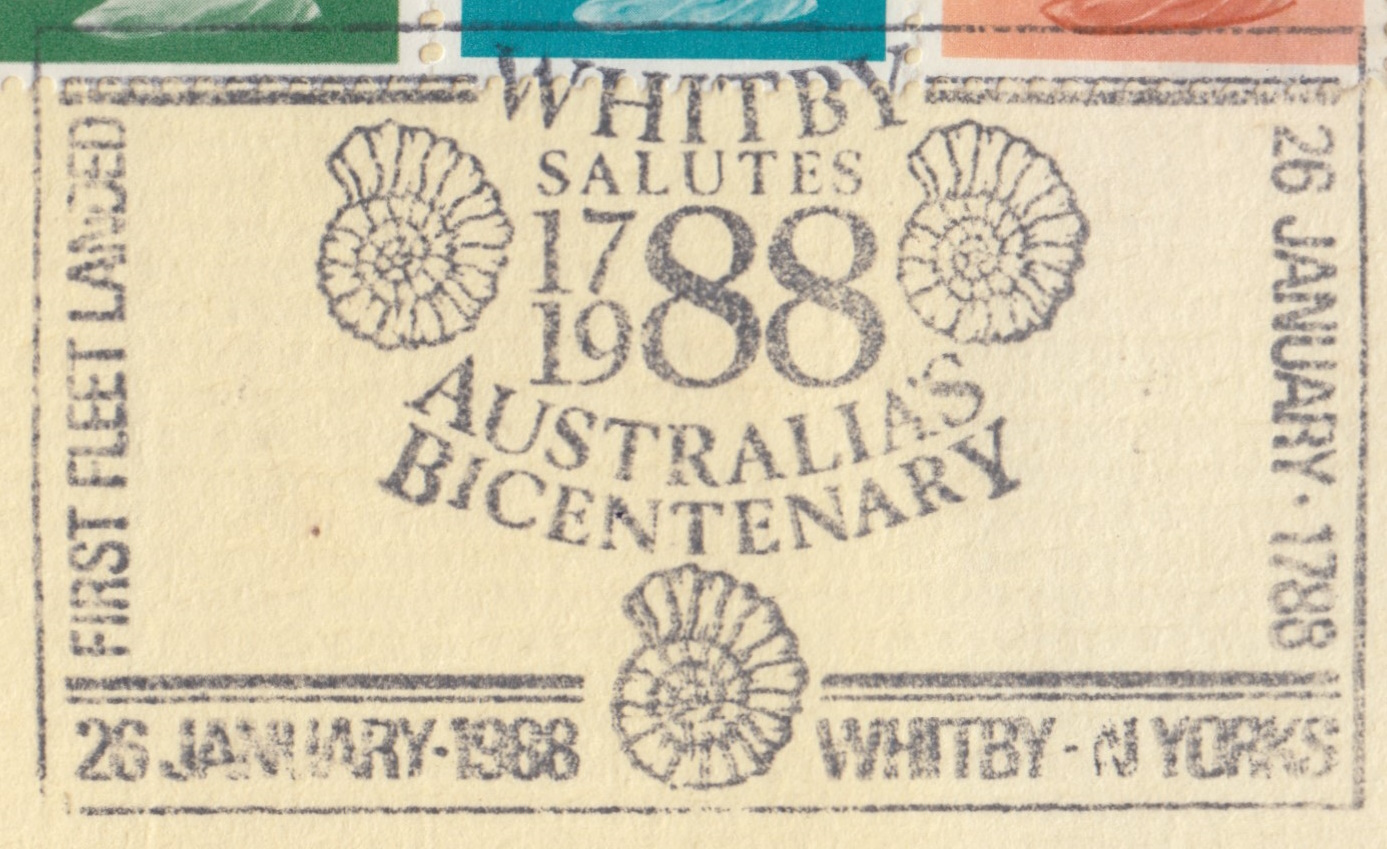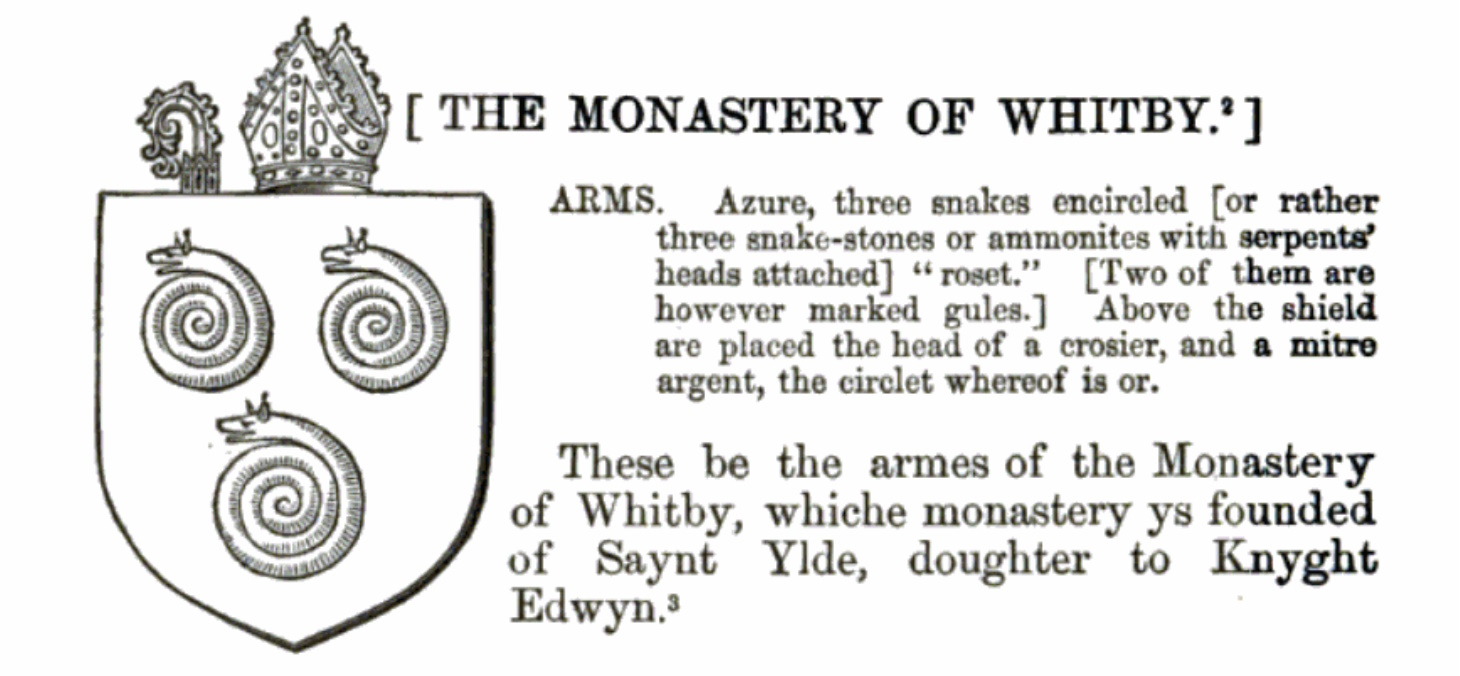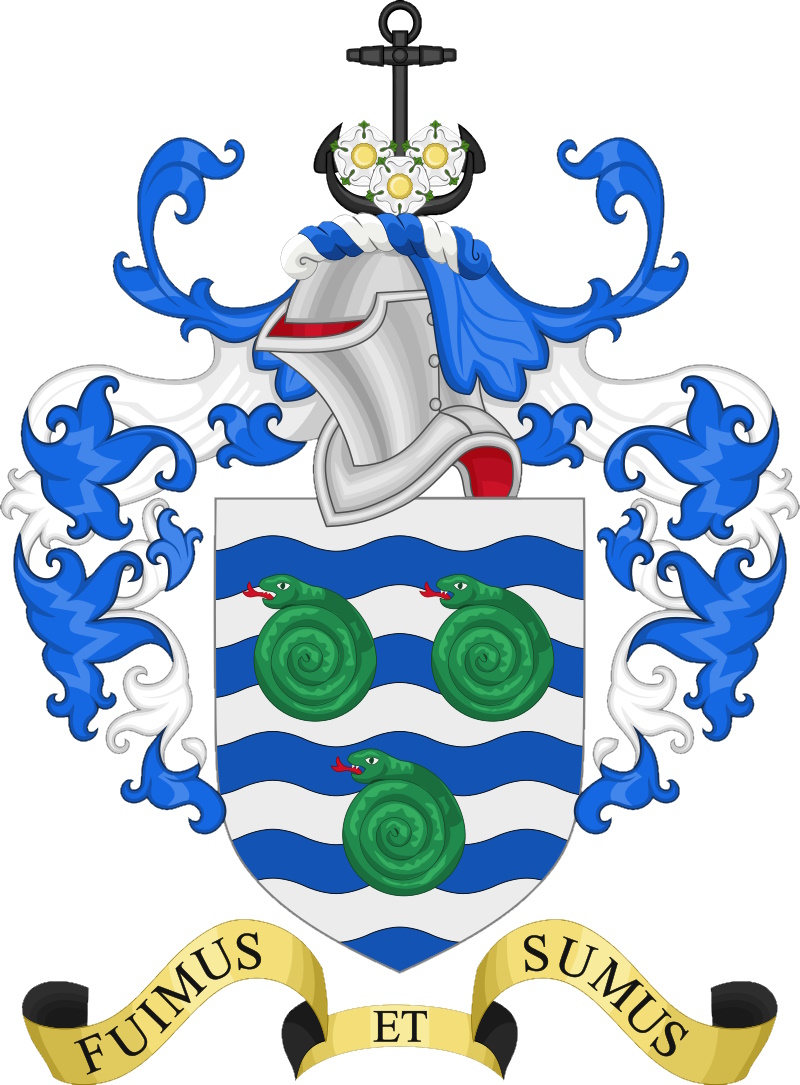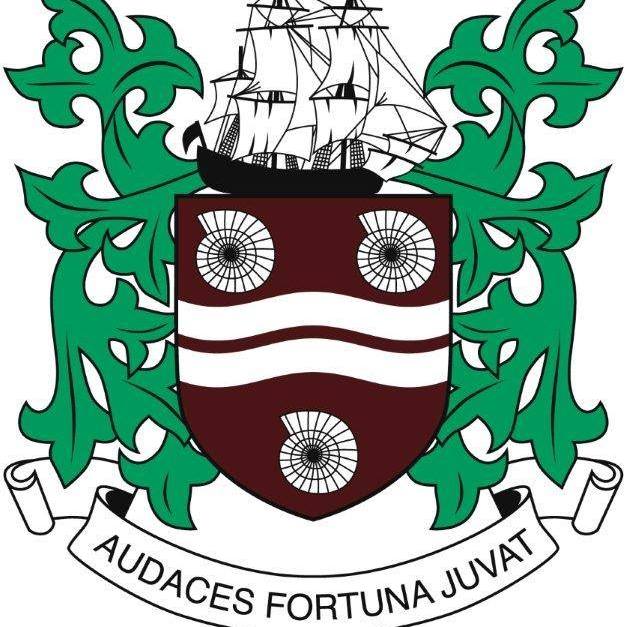United Kingdom 1988 "Whitby salutes Australia's Bicentenary"

Three Ammonites are depicted on the postmark "Whitby salutes Australia's Bicentenary", dated 26th of January 1988.
January 26th is Australia Day, the official National Day of Australia. Observed annually on 26 January, it marks the 1788 landing of the First Fleet and raising of the Union Flag by Arthur Phillip at Sydney Cove in New South Wales.
The ammonites, most likely, are Hildoceras bifrons - one of the most common ammonite species present at Whitby.Two other very common ammonite species of Yorkshire country (Northern England) are: Hildoceras bifrons, Hildoceras semipolitum.
Hildoceras is a genus of small ammonite from the Jurassic Period in the family Hildoceratidae, with diameter between 40mm and 170mm. The shells are characterized by a narrow discoidal evolute shape, keeled venter, concave ribs along the outer flanks, and a shallow spiral groove running along smooth inner flanks. Whorls slightly overlap, cross sections are compressed. The ventral keel is bordered on either side by a shallow groove.

Whitby (from "white settlement" in Old Norse) is a seaside town, port and civil parish in North Yorkshire, England with a population of about fourteen thousand people.
The earliest record of a permanent settlement is in 656 AD, when as Streanaeshealh it was the place where Oswy, the Christian king of Northumbria, founded the first abbey, under the abbess Hilda. The Synod of Whitby was held there in 664 AD. In 867 AD, Viking raiders destroyed the monastery.
In the following centuries Whitby functioned as a fishing settlement until, in the 18th century, it developed as a port and centre for shipbuilding and whaling, the trade in locally mined alum, and the manufacture of Whitby jet jewelry.
The Whitby's port was where Captain James Cook learned seamanship and, coincidentally, where his first vessel to explore the southern ocean, HMS Endeavour was built.
Captain James Cook FRS (1728 – 1779) was a British explorer, cartographer and naval officer famous for his three voyages between 1768 and 1779 in the Pacific Ocean and to New Zealand and Australia in particular. He made detailed maps of Newfoundland prior to making three voyages to the Pacific, during which he achieved the first recorded European contact with the eastern coastline of Australia and the Hawaiian Islands, and the first recorded circumnavigation of New Zealand.
The town lies on the northern part of a coastline, locally described as the "Fossil Coast". The “Fossil Coast” is 56 km long and stretches from Staithes (Northwest of Whitby) and Flamborough (Southeast of Whitby). The rock strata contain various fossils or prehistoric marine animals, including Ichthyosaurs, Plesiosaurs and crocodiles discovered since the middle of 18th century, and even some dinosaur footprints.The fossils of Whitby can be seen in the "Whitby Museum" and in the "Rotunda Museum" in Scarborough which has a comprehensive collection of fossils from the area.
 |
| Snake stone of Whitby. Image credit: the Natural History Museum in London |
Smaller fossils include numerous species of ammonites, or "snake stones" (sometimes written in one word: snakestones) can be found in large quantities at the shoreline near the town.
The town's "snake stones" folklore has it that fossils were once living serpents that were common in the area. These stories attribute to the 7th century AD, Anglo-Saxon Abbess Saint Hilda of Whitby (614-680) with ridding the region of snakes by turning them to stone.
Legend has it that Hilda was required to found an abbey on the cliffs above Whitby. Finding the site to be infested by snakes, she prayed to the Lord and the snakes coiled up and were turned to stone. She picked them up and threw them over the cliff, and that is why there are so many ammonite fossils in the rocks below the abbey.
In early Christian times, snakes had a bad reputation and were associated with the Devil, so it was important
to clear the area before a sacred building could be established.
According to legend, Saint Hilda cast a spell that turned the snakes of Whitby to stone and threw them from
the cliff tops.
says Dr. Paul Taylor from Natural History Museum in London.

|
Arms of Whitby Abbey. Image credit: "Heraldic Visitation of the Northern Counties in 1530 by Thomas Tonge, Norroy King of Arms Edited by W. Hylton Dyer Longstaffe, F.S.A. Published in 1863." |
 |
| Snake stones of Whitby on half penny token of Henry Sneaton's from 1667 |
 |
| Snake stones on Whitby Association token from 1811 |
When Whitby's nuns exalting told,
Of thousand snakes, each one
Was changed into a coil of stone,
When Holy Hilda pray'd:
Themselves, without their holy ground,
Their stony folds had often found.
Local collectors and dealers in fossils often carved heads on ammonites to increase curiosity value and improve sales.
These "snake stones" became the symbol of Whitby and started to appear on the coat of arms and other symbols associated with the town in the sixteenth or seventeenth century.
In 1667, three coiled "snake stones" with heads, as they were shown on the Arms of Whitby Abbey, appeared on a "HIS HALF PENNY" copper token of local merchant Henry Sneaton (see on the right).
From the middle of the 17th to the early 19th century,
England suffered from a chronic shortage of small change.
The British government failed to mint enough small change coins for commerce, creating hardship,
especially for the urban poor.
This forced local merchants and municipalities to produce their own tokens for daily commerce.
Merchants and municipalities issued farthings, halfpence and penny tokens mostly made of copper
or brass and often featuring designs related to the issuer, such as a coat of arms or a symbol of their trade.
Although most examples were round, some were octagonal, square or even heart shaped.
As long as merchants accepted the tokens for purchases at face value, the public would accept them in change.
Since 1935, the Whitby Coat of Arms has incorporated three snakestones due to this folklore. The rugby club of Whitby have the ammonites on its coat of arms and Whitby Town Football Club have the ammonite design on its crest.
 |
 |
 |
| Coat of Arm of Whitby | Coat of Arm Rugby club of Whitby | St. Hilda monument in Whitby |

|

|
|
"Treasures of the Natural History Museum" [in London] Amazon: USA, UK, DE. |
- Whitby:
Whitby Town Council,
Wikipedia.
- Whitby Abbey:
- english-heritage.org
- Visit Whitby (the article does not exist anymore)
- "Heraldic Visitation of the Northern Counties in 1530 by Thomas Tonge, Norroy King of Arms. Edited by W. Hylton Dyer Longstaffe, F.S.A. Published in 1863."
- Hilda of Whitby: Wikipedia.
- Whitby Abbey:
- "Snakestones" - Ammonites of Yorkshire:
- "Treasures of the Natural History Museum", issued by the Natural History Museum in 2009, ISBN: 0565092359.
- "Fossilien im Volksglauben und im Alltag : Bedeutung und Verwendung vorzeitlicher Tier- und Pflanzenreste von der Steinzeit bis heute.", by Thenius, E; Vávra, N, published in 1996 in Frankfurt am Mein, ISBN: 378291144X.
- "Folklore" book published by London, Folk-lore Society in 1890
- the Natural History Museum in London
- Real Yorkshire blog
- Fossils for sale
- Andys Fossils
- Rotunda Museum official website
- Whitby Museum official website
- Dinosaur's footprints at Whitby: Deposits Mag,
- English token:
- Australia Day Wikipedia
Acknowledgements:
- Many thanks to Dr. Peter Voice from Department of Geological and Environmental Sciences, Western Michigan University, for reviewing the draft page and his very valuable comments.